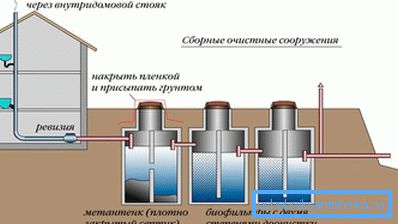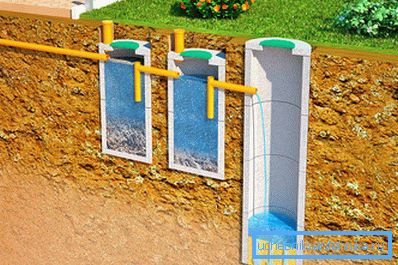Septic ventilation
A septic tank used in a private house is inherently an autonomous closed-type system operating in the mode of accumulating waste and suggesting the presence of unpleasant odors in its location.
In this case, the main reason for the formation and spread of strong odors is the lack of ventilation of the septic tank or the violation of its normal functioning.
It should be noted that, in accordance with sanitary standards, all waste collectors installed in a suburban area must be equipped with a ventilation system. But unfortunately, most users prefer a simpler way and are limited to the use of check valves or hydraulic valves, the use of which does not completely get rid of this unpleasant phenomenon.
Tip! The use of ventilation is a prerequisite for the preservation of a normal environmental situation in the area where the waste collector is located. Moreover, in some cases, unpleasant smells can be felt not only in this area, but also inside the residential building, as a rule, in the toilet and bathroom.
In addition, the normal ventilation of the septic tank will create favorable conditions for the reproduction of microorganisms responsible for the treatment of waste. Since this process is accompanied by intense release of carbon dioxide and heat, the latter must also be removed from the system.
Due to the lack of ventilation, the microorganisms themselves can become a source of unpleasant odors from the septic tank. This is usually observed when the drainage system does not have time to completely filter the drains flowing into it. As a result, the accumulated microorganisms perish en masse, which is accompanied by the release of an extremely unpleasant odor that spreads around the district.
In the subsequent sections of our article, we will consider ways of dealing with the problems mentioned above.
System design

When designing a ventilation system, first of all it is necessary to take into account those anaerobic phenomena that occur in the compartments of your septic tank and require fresh air. Once again, we note that the appearance of an unpleasant odor from a septic tank may be associated with the following processes:
- the accumulation of silt at the bottom of the settler and its subsequent fermentation;
- the formation on this basis of special microorganisms (bacteria) that enhance the processes of decomposition;
- the appearance in the septic tank of colonies of aerobic bacteria that enter the reservoir through the channel of soil purification.
It is clear that in the volumes of the septic tank the natural mixing of the air layers occurs, carried out according to the laws of physics, when warm, light air rises; and cold heavy - goes down. At the same time, due to the difference in temperatures of wastewater and ambient air, a differential atmospheric pressure is created outside and inside the sewage system, which allows combining the after-treatment ventilation system with a special effluent riser that can be displayed on the roof of the house.
When combined, the ventilation of the sewage treatment plant is carried out as follows:
- During operation (in any weather), there is a direct contact between the effluent vapor and the fresh outside air, which is caused by natural heat exchange mechanisms.
- The flow of the heat exchange process for obvious reasons is accompanied by an appropriate air exchange.
- In this case, a pressure differential is formed, contributing to the intensification of air exchange phenomena.
External elements of sewage ventilation

Consider the option of ventilated settling basins on the example of a single-chamber septic tank assembled from concrete rings. In this case, the external ventilation system is constructed of two sewer pipes, one of which (lower, 100 mm) is mounted in the lid, and the second - the upper or above-ground pipe with a section of 50 mm is fixed in the lower with a special adapter.
Tip! The pipe docking site is carefully insulated and protected by a waterproofing layer; moreover, the upper pipe should be displayed above the ground in such a way that the flood waters do not penetrate into the system.
Let us further consider the scheme of a multi-chamber septic tank assembled from the same reinforced concrete rings. In this design, the ventilation pipe is usually removed from the last chamber used for the after-treatment (drainage) of drains.
In other sectors intended for their biological treatment, ventilation, as a rule, is not required.
Recall that from the septic tank after-treatment chamber, the treated drains are discharged through perforated pipes directly into the filter well, after which their natural utilization takes place (dissolving in the soil). To arrange the ventilation of the post-treatment chamber with your own hands, you will need to do the following operations:
- First of all, the end of each perforated pipe (drains) is displayed at a given place on the surface.
- After that, the ventilation pipe itself rises about 0.5 meters above the ground.
- At the final stage of the work, the pipe ends are closed with small canopies protecting them from precipitation.
Tip! The number of vents is selected based on one for every half meter drain.
In conclusion, we note that the tube channels used for ventilation of the absorption and filtration fields can also be used for cleaning (washing) drains and for controlling their functioning. In the first case, water is pumped into the ventilating pipe under high pressure and driven through them towards the septic tank.
The control over the condition of drains is organized by using the vent pipes as inspection hatches. However, the lack of water at the end of the drain indicates that the ventilation is working normally. The presence of water in them is an indicator that the drains are very slowly absorbed into the ground.